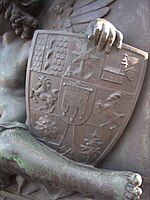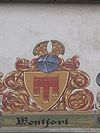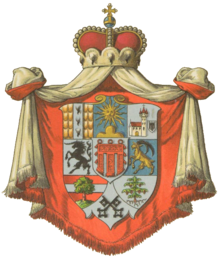Vorarlberg coat of arms
The Vorarlberg coat of arms goes back to the medieval Montfort family. It is the only coat of arms of an Austrian state in which there is no heraldic animal (Vienna only uses an eagle in the large coat of arms).
description
- Legal definition of Section 3, Paragraph 2 of the Law on National Symbols:
- On the silver shield it rests with three equally wide,
- red Montfortic banners with black fringed bibs,
- that has three red rings on the upper edge.
- The upper field of the banner has two,
- the bibs are crossed with three black lines.
The type of the state coat of arms is a church flag . This is on a silver shield (in heraldry, silver corresponds to white) and is equipped with three red rings. It has three equally wide fringed bibs ( hangers ), of which the middle one is longer. In the upper part it is crossed by two thin, parallel, horizontal, black bars, in the bibs by three, whereby they are shifted downwards in the middle bib compared to the other two.
The coat of arms was originally the war coat of arms of the Counts of Montfort , in peacetime a black version was used in which the bars running through the coat of arms were white. Today this forms, in contrast to the state coat of arms, shown in a tapering shield, the coat of arms of the city of Feldkirch . Principles about the coat of arms are already regulated in article six of the Vorarlberg state constitution, so it says there in paragraph one: The country's coat of arms is the Montfortic red banner on a silver shield. According to paragraph four of the sixth article, more details are determined by the law on national symbols.
history


The Montforters, who owned several rulers in the area of today's Vorarlberg ( Feldkirch , Bregenz , Götzis ), but also in southern Germany, used the red church flag on a silver background as their coat of arms . Its name is said to go back to the Latin expression mons fortis , which means something like 'strong / defensive mountain'. For the first time they united several Vorarlberg areas under their rule. Before they finally died out in 1787, they had given the Habsburgs their rule in the 14th and 15th centuries, but their coat of arms has been preserved. The first colored versions of the later national coat of arms appeared in the mid-14th century in the manuscript speculum humanae salvationis and in the Zurich coat of arms .
Vorarlberg, which did not represent a uniform rulership structure but was split up into several rulers, did not have a uniform coat of arms for a long time. Although the Montfort banner became more and more popular as a symbol for the area of today's Vorarlberg, it was not the official coat of arms during the Habsburg Monarchy. Although today's Vorarlberg was co-administered by Tyrol at that time and actually did not represent an independent area, the regional historian Joseph von Bergmann had a first coat of arms designed. This was a combination of several coats of arms from larger municipalities and regions, was crowned by a princely hat and was sometimes placed on a princely coat. It was awarded by an imperial diploma on August 20, 1864. In the first row of this coat of arms there are from left to right the coats of arms of Bregenz , Sonnenberg and Feldkirch , in the second row those of Bludenz and Hohenems , in the bottom row finally the coats of arms of Dornbirn , the Montafon and the Bregenzerwald , and in the heart shield Montfort. In order to emphasize the unity of the country and finally to create a uniform coat of arms, after the proclamation of the republic in 1918, the coat of arms of the Counts of Montfort, the heart shield of the previous coat of arms, was declared the state coat of arms. In the first coat of arms law of 1918, the state coat of arms was still referred to as the "Montfort red war banner", but later on the references to its warlike origin were finally dispensed with.
use
Use of the coat of arms
The right to use the state coat of arms belongs primarily to the president of the state parliament, the members of the state government as well as the authorities, offices and other offices of the state. The right to use the state coat of arms can be granted to corporations under public law, other legal persons or physical persons, if this promotes the public interests of the state, if they perform tasks of the state or are non-profit.
Use of the seal
The state seal is used by the state authorities and the state parliament . The state constitution also standardizes the seal. In the provisions of Article six on the national symbols, paragraph three states:
“ The state seal has the state coat of arms with the inscription 'Land Vorarlberg'. "
The seal stick is kept by the state government; only this and the state parliament president are authorized to keep it. Hard print and color stamps that differ from the seal in that they have authority designations in the transcription, may only be used by authorized institutions. Illegal use of the seal by unauthorized persons can result in fines of up to 2000 euros.
Use in the state service flag
Positioned in the middle of the state flag, the coat of arms forms the so-called state service flag. As in the case of the Siegel, the President of the State Parliament and the State Government are primarily authorized to lead . It is also used by the state parliament and the state authorities , especially on meeting or public holidays and also in connection with the federal service flag or the national flag .
Individual evidence
- ↑ while Feldkirch, with the black flag, refers to the peace flag of the Montforters
literature
- Office of the Vorarlberg state government: the coat of arms of the state of Vorarlberg - the logo of the state of Vorarlberg - application aid. Status 2010 (with the exact regulations on appearance and use, pdf , vorarlberg.at)
- Karl Heinz Burmeister : The Vorarlberg state coat of arms. In: Cornelia Albertani: Vorarlberger Landessymbole. A project of the Vorarlberg State Archives and the Ludwig Boltzmann Institute for Regional Research in Social Sciences . Published by Ulrich Nachbaur . Vorarlberger Verlags-Anstalt, Dornbirn 2004, ISBN 3-85430-319-X (= investigations into the structural history of Vorarlberg 5; also Montfort. Quarterly journal for history and present Vorarlbergs vol. 56, issue 1/2, ISBN 978-3-85430-343 -5 , pp. 28–35; article, pdf , vorarlberg.at.)
- Peter Diem : The symbols of Austria. Time and history in signs . Kremayr & Scheriau, Vienna 1995, ISBN 3-218-00594-9 , p. OA
- Ulrich Nachbaur : The Vorarlberg state coat of arms from 1864. A contribution to the state and state symbolism. In: Montfort. Quarterly publication for the past and present of Vorarlberg vol. 60, issue 4, 2008, ISBN 978-3-85430-343-5 , pp. 235–270. ( Article, pdf , vorarlberg.at)
- Ulrich Nachbaur : Legal texts on the Vorarlberg regional symbols. In: Cornelia Albertani: Vorarlberger Landessymbole. A project of the Vorarlberg State Archives and the Ludwig Boltzmann Institute for Regional Research in Social Sciences . Published by Ulrich Nachbaur. Vorarlberger Verlags-Anstalt, Dornbirn 2004, ISBN 3-85430-319-X (= investigations into the structural history of Vorarlberg 5; also Montfort. Quarterly journal for history and present Vorarlbergs vol. 56, issue 1/2, p. 107 ff .; pdf , vorarlberg.at)






